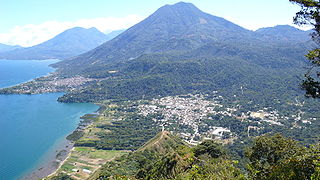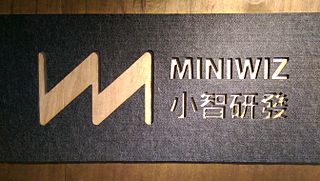
Sololá is a department in the west of Guatemala. The capital is the city of Sololá. Lake Atitlan is a key feature surrounded by a number of the municipalities.

Sololá is a city in Guatemala. It is the capital of the department of Sololá and the administrative seat of Sololá municipality. It is located close to Lake Atitlan.

Volcán Atitlán is a large, conical, active stratovolcano adjacent to the caldera of Lake Atitlán in the Guatemalan Highlands of the Sierra Madre de Chiapas range. It is within the Sololá Department, in southwestern Guatemala.

Lake Atitlán is a lake in the Guatemalan Highlands of the Sierra Madre mountain range. The lake is located in the Sololá Department of southwestern Guatemala. It is known as the deepest lake in Central America.

Tolimán is a stratovolcano in Guatemala, on the southern shores of Lake Atitlán. Part of the Sierra Madre mountain range, the volcano has an elevation of 3,158 m and was formed near the southern margin of the Pleistocene Atitlán III caldera. The top of the volcano has a shallow crater and its flanks are covered with the thick remains of ancient lava flows that emerged from vents in the volcano's flanks.

Volcán San Pedro is a 3,020-metre (9,908 ft) stratovolcano on the shores of Lago de Atitlán, in the Sololá Department of southern Guatemala. It is part of the mountain range of the Sierra Madre.

Panajachel is a town in the southwestern Guatemalan Highlands, less than 140 kilometres (90 mi) from Guatemala City, in the department of Sololá. It serves as the administrative centre for the surrounding municipality of the same name. The elevation is 1,597 metres (5,240 ft). Population was 11 thousand in the 2000 census, projected as 15,830 by June 30, 2020 and has approximately doubled each of the last few decades. The town of Panajachel is located on the Northeast shore of Lake Atitlán, and has become a centre for the tourist trade of the area as it provides a base for visitors crossing the lake to visit other towns and villages.

San Juan La Laguna is a municipality on the southwest shore of Lago de Atitlán, Sololá, Guatemala. It consists of the village named San Juan La Laguna and three smaller aldeas in the nearby mountain. The population is approximately 95% Tz'utujil. Agriculture is most important for the economy, with the service sector growing, especially as the number of tourists increase. The lowest elevation is the shore of Lago Atitlán at 1,562 metres (5,125 ft).

The Tzʼutujil are an Indigenous people, one of the 22 Maya ethnic groups that live in Guatemala. Together with the Xinca, Garífunas and the Ladinos, they make up the 25 ethnic groups in the country. Approximately 100,000 Tzʼutujil live in the area around Lake Atitlán. Their pre-Columbian capital, near Santiago Atitlán, was Chuitinamit. In pre-Columbian times, the Tzʼutujil nation was a part of the ancient Maya civilization.

San Marcos La Laguna is a village on the western shore of Lago Atitlán in the Sololá Department of Guatemala. The village is northwest of three volcanos Volcán San Pedro, Volcán Tolimán, and Volcán Atitlán. The village has an outdoor amphitheater and a few hostels. San Marcos connects to other lakeside communities by boat and a narrow road. The nearest city is Panajachel at the northern side of Lago Atitlán. The town sits at an elevation of 1,585 metres (5,200 ft); the lowest elevation is the lake shore at 1,562 metres (5,125 ft).

San Pedro La Laguna is a Guatemalan town on the southwest shore of Lake Atitlán. For centuries, San Pedro La Laguna has been inhabited by the Tz'utujil people, and in recent years it has also become a tourist destination for its Spanish language schools, nightlife, and proximity to the lake and volcanoes, particularly Volcán San Pedro, at whose base San Pedro La Laguna is located.

Santiago Atitlán is a municipality in the Sololá department of Guatemala.

The Atitlán grebe, also known as giant grebe, giant pied-billed grebe, or poc, is an extinct water bird, a relative of the pied-billed grebe. It was endemic at the Lago de Atitlán in Guatemala at an altitude of 1700 m asl. It was described in 1929 by Ludlow Griscom based on a specimen collected in 1926 and had been overlooked in the past. American ecologist Anne LaBastille observed the decline of this species over a period of 25 years. It was declared extinct by 1990.

Harris Lee Whitbeck Cain is a Guatemalan journalist, author, and television personality currently serving as the director of the Guatemalan Institute of Tourism (INGUAT) for the Bernardo Arévalo administration. Prior to becoming the director of INGUAT, Whitbeck worked as a correspondent and Latin America bureau chief for CNN.
The Guatemala Health Initiative (GHI) is a private, humanitarian organization that works to improve the health of the impoverished indigenous population in the remote areas of Guatemala's western highlands. The GHI is affiliated with the University of Pennsylvania. Faculty, students, and staff address health issues affecting the municipality of Santiago Atitlán. GHI aims to strengthen clinical services and promote community health in resource-poor Guatemalan communities.

Miniwiz is a Taiwanese company that upcycles consumer and industrial waste into construction and consumer products. The company was founded by Arthur Huang. It is headquartered in Taiwan with offices in Milan, Singapore, Beijing, and Shanghai.

An ecobrick is a plastic bottle densely packed with used plastic to create a reusable building block that achieves plastic sequestration.The concept behind ecobricks is to utilize and upcycle post consumer plastic, benefiting our Earth. These plastic bottles are precisely packed with clean and dry used plastic to avoid the growth of bacteria. Ecobricks can be used to produce various items, including furniture, garden walls and other structures. These plastic packed bottles are produced primarily as a means of managing consumed plastic by sequestering it and containing it safely, by terminally reducing the net surface area of the packed plastic to effectively secure the plastic from degrading into toxins and microplastics. Ecobricking is a both an individual and collaborative endeavor. The ecobricking movement promotes the personal ecobricking process as a strategy to raise awareness of the consequences of consumption and the dangers of plastic. It also promotes the collaborative process as a way to encourage communities to take collective responsibility for their used plastic and to use it to produce a useful product.
Tourism became one of the main drivers of Guatemala's economy, an industry that reported more than $1.8 billion in 2008. Guatemala receives about two million tourists annually.
María de la Concepción Ramírez Mendoza was a peace activist from Guatemala, whose portrait appears on the Guatemalan 25 centavo coin, known as the choca.















